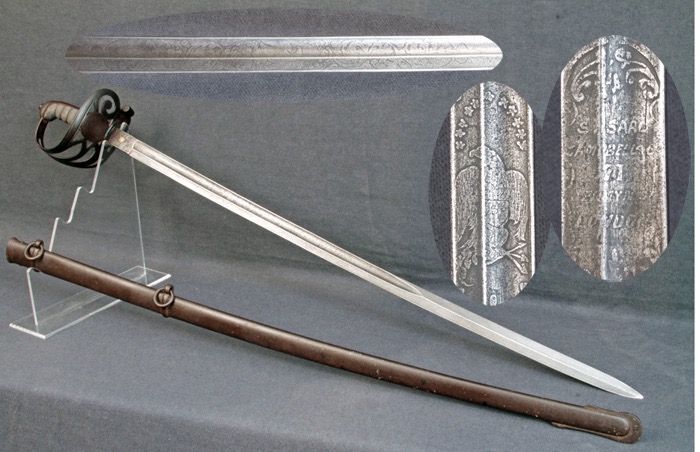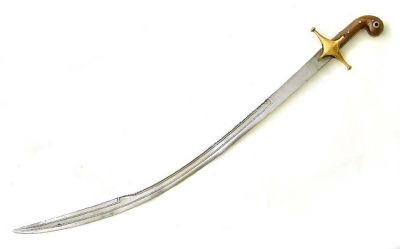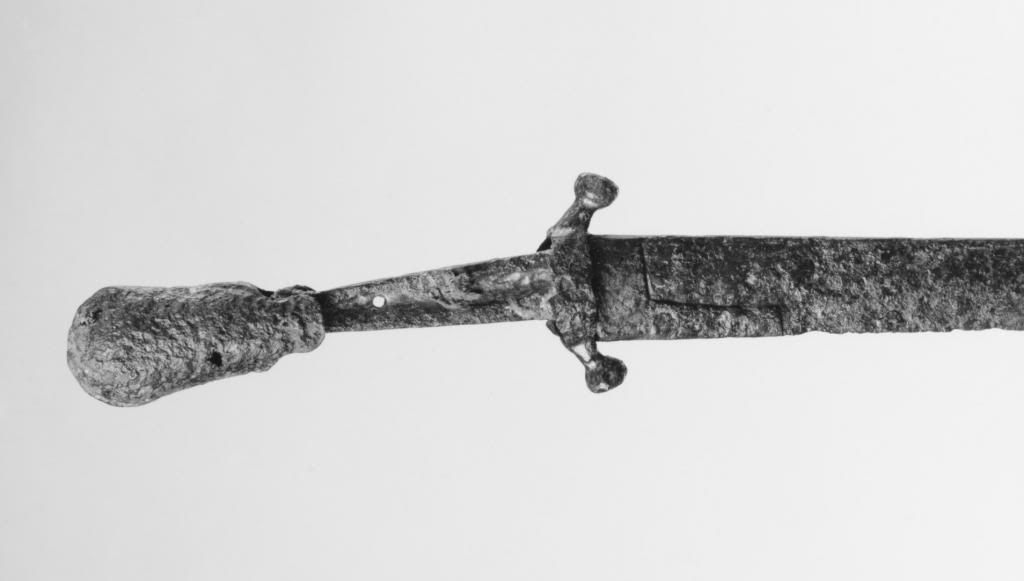| Author |
Message |
|
Zhenyu Li
|
 Posted: Sun 15 May, 2016 8:01 pm Post subject: two edge tip of backsword/saber Posted: Sun 15 May, 2016 8:01 pm Post subject: two edge tip of backsword/saber |
 |
|
I used to believe that the tip looks like from sword with a two edges straight blade didn't not appear in Middle East.But I found an example may made during 11-12 century had a false edge which is very similar to some modern saber.Is this type of false edge popular during middle age in Middle East?And if some sabers have this kind of false edge is because they were came from back sword.What makes these middle age "Kijil" have this kind of false edge which is different from other kind of popular false edge?
 Attachment: 114.93 KB Attachment: 114.93 KB

 Attachment: 48.73 KB Attachment: 48.73 KB

 Attachment: 11.54 KB Attachment: 11.54 KB

|
|
  |
 |
Mikko Kuusirati

|
 Posted: Sun 15 May, 2016 10:02 pm Post subject: Posted: Sun 15 May, 2016 10:02 pm Post subject: |
 |
|
Though notionally single-edged, sabers and scimitars have had false edges for as long as they've existed, several centuries before they were commonly adopted in the Middle East; the very earliest finds of Avar sabers, around 600CE, already feature this type of false edge. It has nothing to do with the European backsword, which is a much later development.
PS. Here's one example of a spear-pointed Avar saber from the Metropolitan Museum of Art, of the type Middle Eastern shamshir, kilij etc. are thought to have developed from:


Note the L-shaped collar, a rare feature on later Middle Eastern sabers but almost ubiquitous on these early steppe swords and also present on the blade you posted.
"And sin, young man, is when you treat people like things. Including yourself. That's what sin is."
— Terry Pratchett, Carpe Jugulum
|
|
  |
 |
|
Zhenyu Li
|
 Posted: Mon 16 May, 2016 8:17 am Post subject: Posted: Mon 16 May, 2016 8:17 am Post subject: |
 |
|
| Mikko Kuusirati wrote: | Though notionally single-edged, sabers and scimitars have had false edges for as long as they've existed, several centuries before they were commonly adopted in the Middle East; the very earliest finds of Avar sabers, around 600CE, already feature this type of false edge. It has nothing to do with the European backsword, which is a much later development.
PS. Here's one example of a spear-pointed Avar saber from the Metropolitan Museum of Art, of the type Middle Eastern shamshir, kilij etc. are thought to have developed from:


Note the L-shaped collar, a rare feature on later Middle Eastern sabers but almost ubiquitous on these early steppe swords and also present on the blade you posted. |
I actually meant the modern European sabre have connect to European backsword...
|
|
  |
 |
Mikko Kuusirati

|
 Posted: Mon 16 May, 2016 8:25 am Post subject: Posted: Mon 16 May, 2016 8:25 am Post subject: |
 |
|
| Zhenyu Li wrote: | | I actually meant the modern European sabre have connect to European backsword... |
Ah! My misunderstanding. 
But in answer to your actual questions, then - yes, that type of false edge was popular on early Middle Eastern sabers before the development of the raised yelman that became characteristic of later types, and the reason for its popularity is that it was a typical feature of the even older steppe nomad swords those early sabers were inspired by.
BTW, another sword of this early type is the alleged saber of Charlemagne in the Kunsthistorisches Museum Wien, most probably dating from some time around 900CE (and thus not actually directly connected with Charlemagne).
"And sin, young man, is when you treat people like things. Including yourself. That's what sin is."
— Terry Pratchett, Carpe Jugulum
|
|
  |
 |
|
Zhenyu Li
|
 Posted: Mon 16 May, 2016 1:28 pm Post subject: Posted: Mon 16 May, 2016 1:28 pm Post subject: |
 |
|
| Mikko Kuusirati wrote: | | Zhenyu Li wrote: | | I actually meant the modern European sabre have connect to European backsword... |
Ah! My misunderstanding. 
But in answer to your actual questions, then - yes, that type of false edge was popular on early Middle Eastern sabers before the development of the raised yelman that became characteristic of later types, and the reason for its popularity is that it was a typical feature of the even older steppe nomad swords those early sabers were inspired by.
BTW, another sword of this early type is the alleged saber of Charlemagne in the Kunsthistorisches Museum Wien, most probably dating from some time around 900CE (and thus not actually directly connected with Charlemagne). |
Thank you!And another question I have is did the kind of two handed saber(swiss saber)which was popular in Zwitzerland and German area have some connections with early middle east swords?
|
|
  |
 |
Mikko Kuusirati

|
 Posted: Tue 17 May, 2016 12:33 am Post subject: Posted: Tue 17 May, 2016 12:33 am Post subject: |
 |
|
| Zhenyu Li wrote: | | Thank you!And another question I have is did the kind of two handed saber(swiss saber)which was popular in Zwitzerland and German area have some connections with early middle east swords? |
I don't think there's any direct connection, no - they share a distant ancestor in the early nomad sabers of the Eurasian steppe, but that's about it. Of course there was a lot of cultural trade back and forth, but Eastern Europe developed its own lineage of sabers quite distinct from their Middle Eastern counterparts, and that's where the two-handed Schweizersäbel comes from.
"And sin, young man, is when you treat people like things. Including yourself. That's what sin is."
— Terry Pratchett, Carpe Jugulum
|
|
  |
 |
|
Zhenyu Li
|
 Posted: Tue 17 May, 2016 3:06 pm Post subject: Posted: Tue 17 May, 2016 3:06 pm Post subject: |
 |
|
| Mikko Kuusirati wrote: | | Zhenyu Li wrote: | | Thank you!And another question I have is did the kind of two handed saber(swiss saber)which was popular in Zwitzerland and German area have some connections with early middle east swords? |
I don't think there's any direct connection, no - they share a distant ancestor in the early nomad sabers of the Eurasian steppe, but that's about it. Of course there was a lot of cultural trade back and forth, but Eastern Europe developed its own lineage of sabers quite distinct from their Middle Eastern counterparts, and that's where the two-handed Schweizersäbel comes from. |
I am not sure how people called it during it was still used by Army.But it looks more like something between long sword and messer.I think it... may have nothing to do with Early nomad swords?
|
|
  |
 |
Mikko Kuusirati

|
 Posted: Wed 18 May, 2016 2:59 pm Post subject: Posted: Wed 18 May, 2016 2:59 pm Post subject: |
 |
|
| Zhenyu Li wrote: | | I am not sure how people called it during it was still used by Army. |
Most probably just "large sword" or "large saber" in their native language, most of the time. That's how it always goes. 
| Quote: | | But it looks more like something between long sword and messer.I think it... may have nothing to do with Early nomad swords? |
No direct connection, at any rate. And since there's most of a thousand years between them the stylistic lineage is debatable, too.
"And sin, young man, is when you treat people like things. Including yourself. That's what sin is."
— Terry Pratchett, Carpe Jugulum
|
|
  |
 |
|
Zhenyu Li
|
 Posted: Wed 18 May, 2016 10:31 pm Post subject: Posted: Wed 18 May, 2016 10:31 pm Post subject: |
 |
|
| Mikko Kuusirati wrote: | | Zhenyu Li wrote: | | I am not sure how people called it during it was still used by Army. |
Most probably just "large sword" or "large saber" in their native language, most of the time. That's how it always goes. 
| Quote: | | But it looks more like something between long sword and messer.I think it... may have nothing to do with Early nomad swords? |
No direct connection, at any rate. And since there's most of a thousand years between them the stylistic lineage is debatable, too. |
OK,thanks again 
|
|
  |
 |
|
|
You cannot post new topics in this forum
You cannot reply to topics in this forum
You cannot edit your posts in this forum
You cannot delete your posts in this forum
You cannot vote in polls in this forum
You cannot attach files in this forum
You can download files in this forum
|
All contents © Copyright 2003-2025 myArmoury.com — All rights reserved
Discussion forums powered by phpBB © The phpBB Group
Switch to the Basic Low-bandwidth Version of the forum
|

